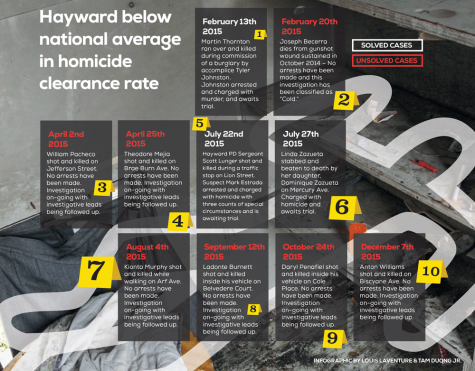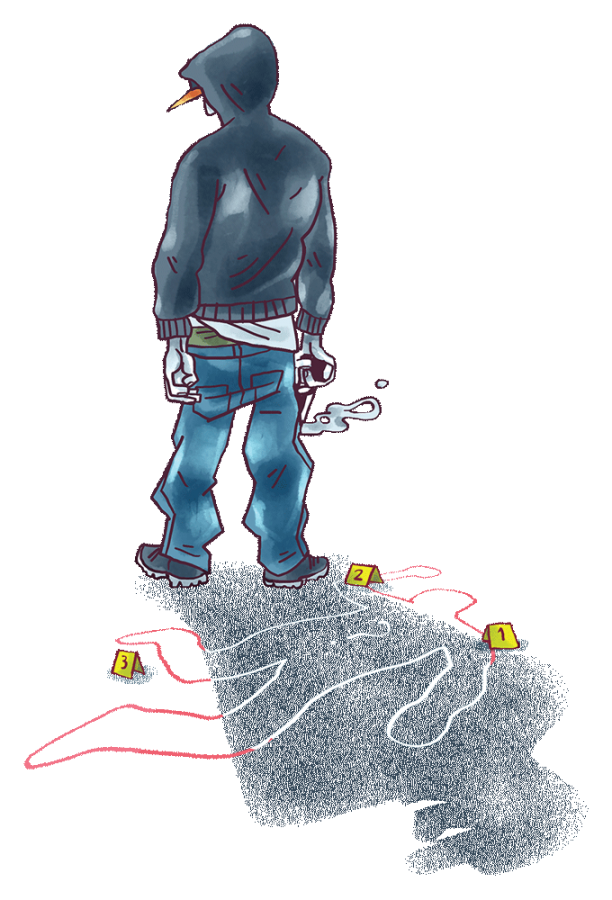Unsolved homicides increase in Hayward
January 14, 2016
Hayward Cold Cases
Hayward isn’t known for its number of homicides, it rarely reaches double figures in a calendar year. However, in 2015, it was known as the city where those cases became increasingly harder to solve.
Three out of the 10 homicide cases that occurred in Hayward in 2015 have resulted with a suspect in custody. The other seven have been classified as “cold” or “under investigation,” according to Hayward Police Sgt. Ryan Cantrell.
This is a far cry from the two previous years in the East Bay city. According to the FBI crime statistics, Hayward had nine crimes classified as a murder or manslaughter in 2014 and they were all cleared. In 2013, the city had seven, and five of those cases were cleared.
Contrary to that trend, in 2012, there were six homicides and only one was cleared, similar to 2011, where only one of seven were cleared.
Nineteen of the 37 homicides in Hayward over the past five years have a suspect in custody or have been cleared which gives the city just over a 50 percent clearance rate for those crimes. According to the FBI, the national “clearance rate” for homicides is 64.1 percent.
The process: the first 48 hours
The HPD Homicide and Major Assaults unit consists of a sergeant and five detectives. According to Cantrell, detectives are assigned cases on a rotational basis and are called out immediately once the death has been reported or discovered. “The detectives work the cases on a team concept, with a primary detective assigned to coordinate all the investigative efforts,” Cantrell said. “Some evidence is collected via search warrants and court orders issued by the courts and other evidence is supplied by witnesses and other involved parties via consent.”
Cantrell said that there are several barriers that prevent the investigation team from solving cases. Some of those include uncooperative witnesses, family members and or lack of physical evidence. He went on to further say that just because they develop information that points to suspects, “proving it beyond a reasonable doubt can often be difficult.”
Cantrell did acknowledge that some of the crimes are gang related; however that is not always the primary reason. “We have gangsters that get murdered, but that doesn’t mean that the cause of their death was from their gang related activities,” Cantrell said.
The most recent homicide was on Dec. 7, on Biscayne Avenue, when 31-year-old Hayward native Anton Lee Williams was shot and killed. According to HPD, the case is “on-going with investigative leads being followed up on.”
Hayward usually has had anywhere from four to 13 murders a year, according to the FBI and with the exception of 2014, there are always cases that end up unsolved. Timeliness is a major factor, not just the process, to solve these crimes but also how many end up being cleared.
“The first 48 hours in an investigation is truly a timeline that we work cases diligently, but it’s actually about 2 to 3 weeks of running exclusively on an investigation to collect as much information,” Cantrell said. “That’s when the case is the freshest and we need to immediately corral all witnesses and try to preserve evidence before it’s destroyed or purged. Sometimes cases get solved within hours, sometimes it takes years or even decades.”

The streets talk
Saul Jimenez has lived in Hayward his entire life and also worked as a counselor at the Hayward based non-profit organization Eden Youth Center, which deals directly with at-risk youths and families. He has seen his fair share of murder cases in Hayward.
“It’s been going on forever,” Jimenez said. “A lot of these murders that don’t get solved aren’t because they don’t know who did it, it’s because people are scared to talk. Several times during counseling I encountered people who had information on violent crimes but were scared to testify because they would be labeled as a snitch or a rat. Gang violence and culture has a lot to do with that.”
Jimenez referred to the Aug. 2000 murder of 19-year-old Johnny Bennett Jr. who was walking home in South Hayward when a car pulled up and the occupants inside the vehicle shot and killed him. At the time the Hayward Police Department believed gang members, who mistook him for a rival gang member, murdered Bennett. Despite receiving several investigative leads Bennett’s murder is still unsolved and classified as cold.
“The streets talk,” Jimenez said. “People knew who did it but they were scared of retaliation. I gotta go point somebody out in court, now they know who I am and me and my family have to worry about retaliation? That was the main thing that prevented solving that case to me.”
While Cantrell said cold cases do get reopened occasionally, when new evidence is found, that it is rare. In certain cases, witnesses can be offered protection but it often includes relocation and in some extreme cases identity reassignment.
















